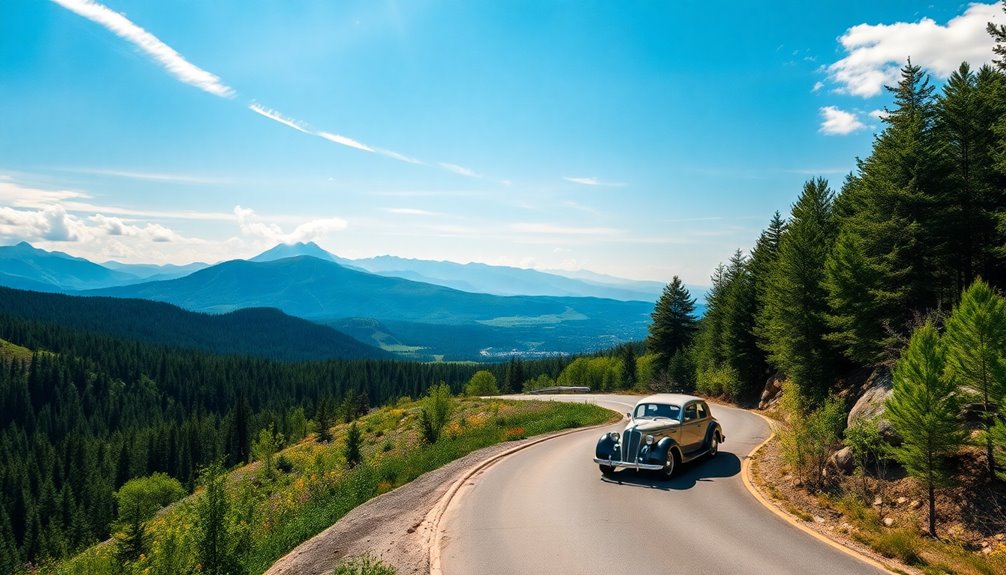To choose the perfect road trip route, start by planning ahead to uncover hidden gems and avoid crowded spots. Consider your vehicle's capabilities and desired scenery. Use navigation apps for real-time updates and nearby fuel prices. Embrace flexibility in your itinerary, allowing for spontaneous detours and local experiences. Don't forget to take regular breaks to stretch and enjoy the surroundings. Keep an eye out for more tips that can make your journey even more enjoyable!
Key Takeaways
- Assess your vehicle's capabilities and comfort features to ensure it can handle the planned road trip distance and terrain.
- Prioritize scenic routes that include national parks and coastal highways for a more visually enjoyable journey.
- Utilize navigation tools like Google Maps and Roadtrippers for offline access and to plan stops at attractions along the way.
- Schedule regular breaks every two hours to stretch, refuel, and explore local dining options for an authentic experience.
- Include flexibility in your itinerary to allow for spontaneous detours that can lead to hidden gems and memorable experiences.
The Importance of Planning Your Route
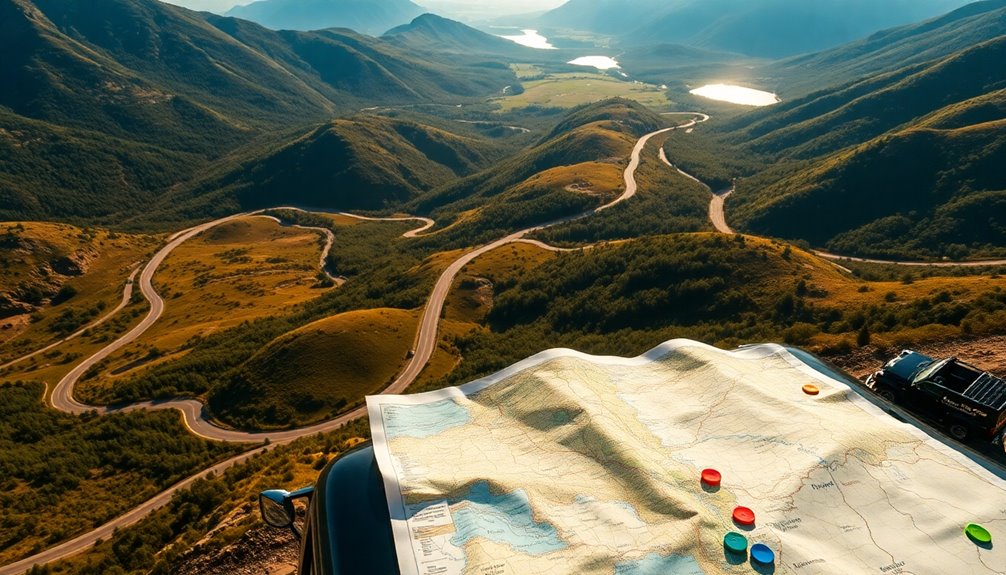
When you take the time to plan your road trip route, you open up a world of unique attractions and breathtaking landscapes that you might otherwise overlook.
Careful planning enhances your overall enjoyment by allowing you to discover scenic drives, like those through national parks or along coastal highways. Prioritizing safety in your route guarantees that the journey is as enjoyable as the destination.
Consider factors like weather, desired scenery, and driving distance to create a route that fits your preferences. Plus, incorporating flexibility lets you take spontaneous detours, enriching your travel experience beyond the initial itinerary.
Key Factors to Consider
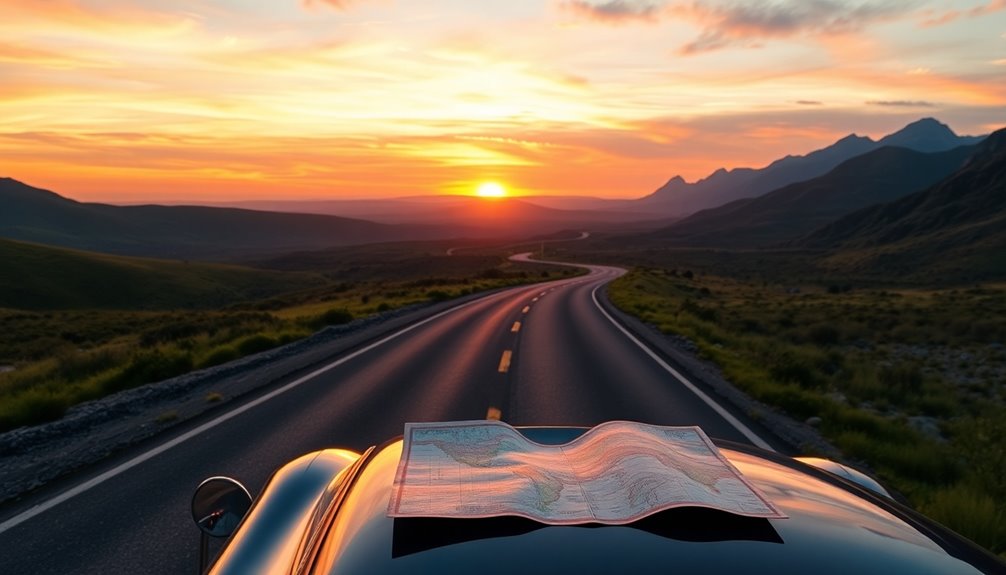
When planning your road trip, you need to assess your vehicle's capability for long distances and the terrain you'll encounter.
Think about the scenery you want to experience—whether it's coastal views or mountain landscapes—as this will shape your route. Additionally, consider incorporating some hidden gems for camping along the way to enhance your overall adventure.
Vehicle Capability Assessment
Before hitting the road, it's crucial to assess your vehicle's capabilities to guarantee a smooth journey.
Start with a vehicle capability assessment focusing on fuel efficiency, as it directly impacts your budget and planning for fuel stops. If you're bringing extra gear or a trailer, check your towing capacity to make sure your vehicle can handle the load safely.
Don't forget to evaluate comfort features like seating and climate control; these can make long drives much more enjoyable. If your adventure includes unpaved roads, verify your vehicle has the right off-road capabilities.
Finally, confirm that your vehicle's maintenance is ideal—inspect brakes, tires, and fluid levels to prevent any breakdowns during your trip. Additionally, consider incorporating landscaping elements to enhance your road trip experience by creating scenic stops along the way.
Scenic Preferences Evaluation
How do your scenic preferences shape the road trip experience? Your desired scenery—whether it's mountains, deserts, or coastal views—plays a crucial role in enhancing your journey.
Research popular scenic drives like the Pacific Coast Highway or Blue Ridge Parkway, known for their breathtaking landscapes. Consider seasonal changes; routes often look stunning during specific times, like fall foliage in New England or blooming wildflowers in the Southwest.
Don't forget to include national parks, lakes, and unique geological formations along your route for a diverse experience. Use mapping tools to explore alternative routes, prioritizing picturesque byways over direct highways. Incorporating snack options like garlic herb butter or marinated olives can enhance your travel experience on the road.
This way, you'll create a road trip filled with unforgettable sights and memories.
Essential Tools and Apps for Navigation
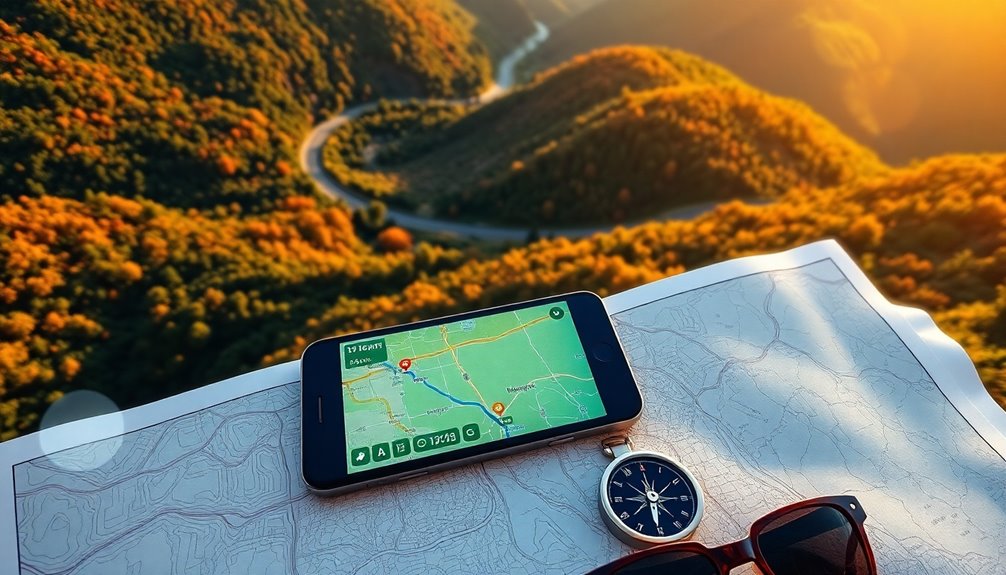
When planning your road trip, having the right navigation tools can make all the difference.
You'll want to explore apps that offer offline mapping options and real-time traffic updates to keep you on track.
Let's look at some essential tools that can enhance your travel experience and help you navigate seamlessly.
Navigation Apps Overview
Finding your way on the open road has never been easier, thanks to a variety of navigation apps designed to enhance your travel experience. Here's a quick overview of some must-have tools:
| App Name | Features |
|---|---|
| Google Maps | Step-by-step directions, traffic updates |
| Waze | Live traffic alerts, user-generated route suggestions |
| Roadtrippers | Plan trips with stops for food and attractions |
| AAA TripTik | Maps gas stations and restaurants |
| GasBuddy | Finds nearby gas prices for budgeting |
With these navigation apps, you can optimize your journey, save money, and enjoy the ride. Additionally, consider visiting regional water parks along your route for family-friendly destinations that offer leisure and recreation. Whether you want real-time traffic updates or route suggestions, these apps have your back as you explore the open road.
Offline Mapping Options
Many road trippers underestimate the importance of offline mapping options.
When you're in remote areas, apps like Google Maps let you download specific regions for navigation without an internet connection.
The Roadtrippers app not only helps you plan your trip in detail but also features offline mapping to discover attractions along the way.
Waze is another reliable tool, allowing you to download maps for offline use, ensuring you stay on course when cell service wanes.
For a dedicated offline experience, Maps.me offers detailed maps and points of interest, making navigation seamless without data or Wi-Fi.
Finally, CityMapper can be a lifesaver in urban areas, providing public transport directions and walking routes offline, perfect for any travel writer on the road. Additionally, having a good sense of color accuracy can enhance your experience when documenting your journey visually.
Real-Time Traffic Updates
Offline mapping options are important, but they don't replace the value of real-time traffic updates.
Apps like Waze provide instant alerts about accidents and road closures, helping you find faster routes.
Google Maps offers live traffic information and suggests alternatives if congestion arises.
Meanwhile, Apple Maps notifies you of slow-moving traffic, ensuring you can adjust your plans on the fly.
For added insights, TomTom Traffic uses user GPS data to reroute you effectively, while Inrix Traffic Information combines historical data with real-time analytics to predict congestion patterns.
By leveraging these tools, you'll get the best route recommendations, making your road trip smoother and more enjoyable. Additionally, utilizing natural language processing in navigation apps can enhance user interactions by providing personalized recommendations based on your preferences.
Don't hit the road without these essential updates!
How to Create a Flexible Itinerary

How can you create a flexible itinerary that keeps your road trip exciting? Start by mapping out your main destinations and identifying must-see attractions, but don't forget to include optional stops to explore along the way.
Allow for adjustments based on your travel pace and group preferences, ensuring a truly flexible itinerary. Incorporate buffer time between activities to accommodate spontaneous detours and unexpected finds.
Use apps like Google Maps or Roadtrippers to visualize your route and adjust it in real-time based on traffic or road conditions. Regularly check in with your travel companions to reassess interests, making it easy to pivot and enhance your experience on the road. Additionally, consider exploring nearby camping locations to enrich your journey with outdoor adventures.
Enjoy the journey!
Preparing Your Vehicle for the Journey
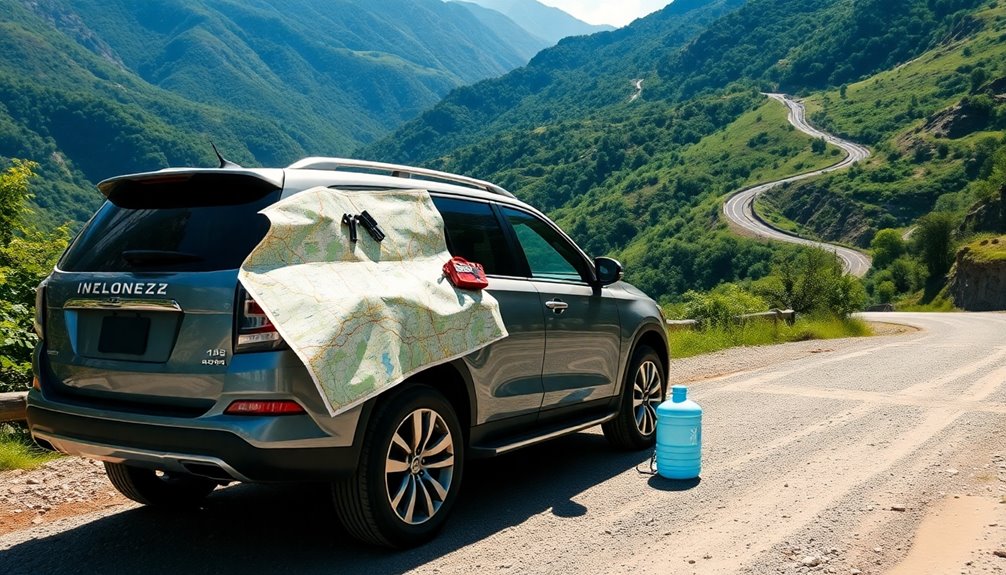
After mapping out your flexible itinerary, it's time to make certain your vehicle is ready for the adventure ahead. Start by scheduling a thorough vehicle maintenance check at least two weeks before departure. This makes sure all systems, including the battery, engine, and tires, are functioning properly.
Verify your tire pressure and tread depth to enhance fuel efficiency and minimize blowout risks. Don't forget to check fluid levels—oil, brake, coolant, and power steering—and top them off as needed. Familiarize yourself with your vehicle's manual for any specific pre-trip recommendations. Additionally, consider implementing budget-friendly maintenance plans to keep your vehicle in optimal condition throughout your travels.
Finally, prepare an emergency kit that includes a spare tire, jumper cables, and a first aid kit, making sure you're equipped for unexpected situations during your trip.
Tips for a Memorable Road Trip Experience

While planning your route is essential, the real magic of a road trip lies in the experiences you create along the way. Careful planning helps you discover unique roadside attractions and scenic backroads that enrich your road trip travel.
Make sure to incorporate lesser-known landmarks into your planned itinerary to avoid crowds and enjoy a more immersive experience. Regular breaks every two hours or 100 miles are vital for staying alert and reducing fatigue.
Embrace spontaneity by allowing for unplanned stops; these often lead to memorable discoveries that you'll cherish. Finally, engage in activities like local dining or exploring hidden gems, as they greatly enhance your journey and create lasting memories.
Happy travels!
Frequently Asked Questions
What Is the Best Route Planner for a Road Trip?
When planning your road trip, choosing the best route planner can make all the difference.
Google Maps is great for customizing routes and adding stops, while the Roadtrippers app helps you discover attractions and dining options along your way.
If you're looking for real-time traffic updates, Waze keeps you informed about delays.
For longer trips, AAA TripTik provides detailed maps that include essential stops like gas stations and restaurants.
Combine these tools for an unforgettable journey!
How to Plan the Perfect Road Trip?
Planning the perfect road trip is like crafting a delicious recipe; you need the right ingredients. Start early by researching routes and booking accommodations to avoid last-minute stress.
Use tools like Google Maps to tailor your journey and uncover hidden gems along the way. Set realistic mileage goals to keep the drive enjoyable, and don't forget an emergency kit for peace of mind.
Embrace spontaneity—those unexpected stops often create the best memories!
How Do I Decide Where to Go on a Road Trip?
To decide where to go on a road trip, start by considering your schedule and how long you can travel.
Think about your comfort level with driving and the type of vehicle you'll use.
Do you want to make frequent stops or take a direct route?
Balance distance with enjoyment, looking for scenic views and unique attractions along the way.
That'll help you find the perfect destination for your adventure!
How to Find Scenic Routes for Road Trips?
Imagine cruising along the Pacific Coast Highway, with breathtaking ocean views on one side and lush cliffs on the other.
To find scenic routes for your road trip, use apps like Google Maps or Roadtrippers to uncover hidden gems.
Don't forget to explore national parks and consider iconic routes like Route 66.
Engaging with travel communities can also lead you to charming small towns and local attractions that enhance your journey.
Happy travels!
Conclusion
In the end, choosing the perfect road trip route can make all the difference in your adventure. With careful planning and the right tools, you’ll create unforgettable memories, just like those carefree days of cruising with the wind in your hair and music blasting. So grab your friends, map out your journey, and hit the road. Embrace the freedom of the open highway and let each turn lead you to new experiences—because that’s what life’s all about! As you embark on this exciting journey, keep in mind the best road trip route strategies to enhance your experience. Consider taking the scenic byways that offer breathtaking views and unique pit stops, allowing you to immerse yourself in the beauty of your surroundings. Remember, it’s not just about the destination; the adventure lies in every mile traveled, every conversation shared, and every unexpected detour you take along the way.
